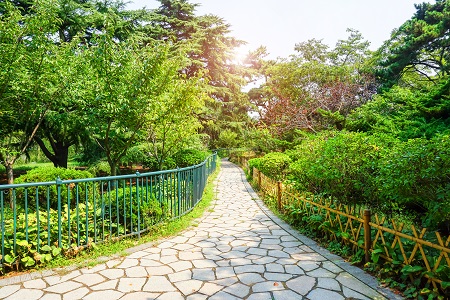Understanding Flagstones
- Feb 14, 2023

Adding a flagstone walkway to your landscape is a great way to add another dimension of color, texture, and utility to it. You have probably seen such walkways and have been impressed by the way they add beauty to the landscape. However, you may also have seen some that detracted from the overall appeal of the garden, instead of adding to it. That is because care was not taken to select the right flagstone. Yes, there is more than one type of flagstone, and knowing what to use for a specific application is critical.
Walkway Paving Options
Here are the key facts that will help you understand flagstones:
- Sedimentary stones such as flagstone, sandstone, limestone and shale are created by the hardening of sediment layers when subjected to high pressure and low heat that bind the strata of clay, sand and organic sediments together. The hardness and strength of this type of stone may vary considerably.
- Igneous rocks such as basalt and granite are from hot molten material originating deep in the earth that becomes solid when it cools. It is often molten lava or magma.
- Metamorphic rocks like quartzite and marble are formed when the sedimentary and igneous rock is subjected to heat, pressure and stress that changes their characteristics. This is how limestone becomes marble and sandstone turns into quartzite.
Read More: What Are the Common Driveway Paving Options? Do You Have the Right One for Your Home?
Which One Is Right for You?
The use of sedimentary sandstone for walkways and patios has been popular for over a century. Being light in weight with a pale color and resistant to absorbing heat, it is widely used in parts of the country where temperatures can go very high and where other stones may become impossibly hot in summer. However, because it is porous, these problems do arise:
- Moisture is absorbed and it starts to flake.
- Low winter temperatures may cause stones to shift.
- Chlorinated water can cause discoloration.
- Wear and tear can cause low spots to develop.
- If water collects, the stones may become stained.
There are a few factors to keep in mind when choosing flagstone walkways.
- Choose stones that are available in many shapes and sizes.
- Glittery stones will lose their sparkle over time.
- If the local water is mineral-rich, dark-colored stones may show efflorescence.
- Brightly colored stones are often softer and wear more quickly.
- If the stones are quarried from far away, the high transportation cost will affect the selling price.
- Find out which flagstones are popular in your area and why.
Read More: What Are Some Good Landscaping Ideas for Small Yards?
Besides the type of flagstone for your walkway, you also have to ensure that the layout, size and shape of the stones all mesh seamlessly with the overall ambiance of the landscape. This is not easy and making a mistake here can lead to a result that will have you pulling your hair out. A landscape is not something you change every few weeks or months. It is a long-term investment in the beauty and comforts your home provides to those who live there. The way to ensure that flagstones for walkways are the right type and are used in the right way is to leave the design and installation of the walkway to a landscaping professional. A landscaping expert will lay out all the options before you and will help you make the right choices so that you get the flagstone walkway that is both what you want and which adds to the beauty of your landscape.














